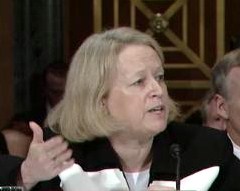By Pam Martens: June 24, 2012
On June 21, 2012, SEC Chair Mary Schapiro submitted 14 pages of testimony to the Senate Banking Committee, explaining why she is fingering her worry beads over a potential panic run on money market funds. It really didn’t require 14 pages of testimony. Schapiro had just two words in the back of her mind: European banks.
Buried in the copious testimony is this daunting fact: as of May 31, 2012, approximately 30 percent of prime money market fund assets is invested in debt issued by banks based in Europe.
What is a money market fund, really, and why is the SEC worrying about a slice of the market that is supposed to hold the shortest and safest investments? It’s because the public perception of what a money market fund is and the reality leaves an expanse as big as the Grand Canyon. In reality, a money market fund is no different than any other mutual fund: it’s a pool of assets in which investors buy a pro rata share. But unlike other mutual funds which must post their net asset value daily, money market funds are allowed to trade at $1.00 per share, giving the perception that if you put $1 in you are always going to get $1 out, i.e., your money market fund won’t ever break the buck.
But now comes the awful truth, as mapped out by Schapiro in this hearing. Money market funds have broken the buck at least 300 times since their inception in 1970 and 100 of those occasions occurred in the crisis month of September 2008. In all 300 occasions, the sponsors added their own funds to shore the money market back up to $1 a share. Here are some of the mileposts that caused money market fund assets to slip below $1:
- Default of Integrated Resources commercial paper in 1989;
- Default of Mortgage & Realty Trust and MNC Financial Corp commercial paper in 1990;
- Bankruptcy of Orange County in 1994 (courtesy of Merrill Lynch derivatives salesman);
- Downgrade and eventual administrative supervision by state insurance regulators of American General Life Insurance Co in 1999;
- Default of Pacific Gas & Electric and Southern California Edison Co. commercial paper in 2001;
- Investments in SIVs, Lehman Brothers, AIG and other financial sector debt securities in 2007-2008
Schapiro mapped out to the Senate how the panic run unfolded in 2008:
The Reserve Primary Fund, a $62 billion money market fund, held $785 million in Lehman Brothers debt on the day of Lehman Brothers’ bankruptcy filing. The Fund immediately began experiencing a run. Shareholders requested redemptions of approximately $40 billion in just two days, i.e. 65 percent of the fund. The Reserve Primary Fund announced that it would re-price its shares below $1.00, or break the buck. The panic spread, first to the Reserve’s family of money market funds, and then to other money market funds. Investors withdrew approximately $300 billion (14 percent) from prime money market funds during the week of September 15, 2008.
Other money market funds were forced to meet their redemption demands by selling their security holdings into markets that were already under stress with values depressed from heavy selling pressure. This panic then spread to the commercial paper market because money market funds began to hoard cash in order to meet redemptions and stopped rolling over existing positions in corporate commercial paper. “In the final two weeks of September 2008,” says Schapiro, “money market funds reduced their holdings of commercial paper by $200.3 billion, or 29 percent.”
Schapiro notes that the retreat from the commercial paper markets by money market funds “caused them to freeze. During the last two weeks in September 2008, companies that issued short-term debt were largely shut out of the credit markets.” When the Federal Reserve was forced by Senator Bernie Sanders to release some details of its lending program on December 1, 2010, I noted that the commercial paper market was in such disarray that big corporations like McDonalds, Caterpillar and Harley-Davidson were selling their commercial paper directly to the Fed.
How did we get out of that panic run? Another taxpayer bailout, of course. In September 2008, the U.S. Treasury guaranteed $3 trillion of money market funds. Can the public rely on that backstop in the future? No. In October 2008, Congress passed the Emergency Economic Stabilization Act (Public Law 110-343) which prohibits the “Exchange Stabilization Fund from the establishment of any future guaranty programs for the United States money market mutual fund industry.”
The SEC is currently exploring several options: one, to allow the net asset value of money market funds to float freely, just like all other mutual funds. (What a novel idea; to make Wall Street price securities at what they are actually worth.) That idea has some big mutual fund companies in an uproar. The second idea would keep the share price at $1 but make the funds’ sponsors maintain a capital buffer, combined potentially with limited restrictions or fees to redeem.
In her summation, Schapiro told the Banking panel that “money market funds as currently structured pose a significant destabilizing risk to the financial system.”


